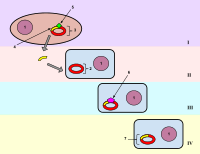
Photo from wikipedia
Stringent response (SR), a primary stress reaction in bacteria and plant chloroplasts, is a molecular switch that provides operational stress-induced reprogramming of transcription under conditions of abiotic and biotic stress.… Click to show full abstract
Stringent response (SR), a primary stress reaction in bacteria and plant chloroplasts, is a molecular switch that provides operational stress-induced reprogramming of transcription under conditions of abiotic and biotic stress. Given that the infection is a stressful situation for both partners, the host plant and the pathogen, we analyzed the expression of bacterial and plastid SR-related genes during plant-microbial interaction. In the phytopathogenic bacterium Pectobacterium atrosepticum, SpoT-dependent SR was induced after contact with potato or tobacco plants. In plants, two different scenarios of molecular events developed under bacterial infection. Plastid SR was not induced in the host plant potato Solanum tuberosum, which co-evolved with the pathogen for a long time. In this case, the salicylic acid defense pathway was activated and plants were more resistant to bacterial infection. SR was activated in the tobacco Nicotiana tabacum (experimental host) along with the activation of jasmonic acid-related genes resulting in plant death. These results are important to more fully understand the evolutionary interplay between plants and symbionts/pathogens.
Journal Title: Phytopathology
Year Published: 2021
Link to full text (if available)
Share on Social Media: Sign Up to like & get
recommendations!